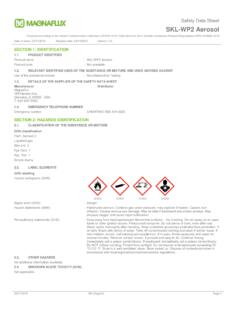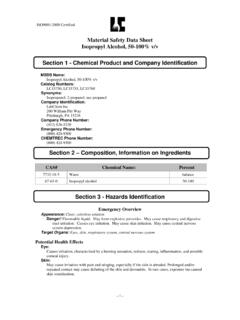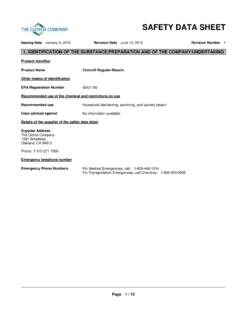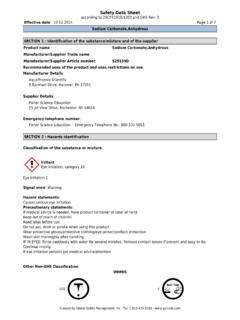Transcription of Safety Data Sheet SKD-S2 Aerosol - Magnaflux
1 Safety data Sheet SKD-S2 Aerosol Prepared according to the Hazard Communication Standard (CFR29 ) HazCom 2012 and the Hazardous Products Regulations (HPR) WHMIS. 2015 Date of issue: 03/18/2016 Revision date: 02/23/2021 Version: SECTION 1: IDENTIFICATION. PRODUCT IDENTIFIER. Product name : SKD-S2 Aerosol Product code : Not available RELEVANT IDENTIFIED USES OF THE SUBSTANCE OR MIXTURE AND USES ADVISED AGAINST. Use of the substance/mixture : Non-Destructive Testing DETAILS OF THE SUPPLIER OF THE Safety data Sheet . Manufacturer Distributor Magnaflux 155 Harlem Ave. Glenview, IL 60025 - USA. T: 847-657-5300. EMERGENCY TELEPHONE NUMBER. Emergency number : CHEMTREC 800-424-9300. SECTION 2: HAZARDS IDENTIFICATION. CLASSIFICATION OF THE SUBSTANCE OR MIXTURE. GHS classification Flam. Aerosol 1. Liquefied gas Eye Irrit. 2A. STOT SE 3. Simple Asphy LABEL ELEMENTS. GHS labeling Hazard pictograms (GHS) : GHS02 GHS04 GHS07. Signal word (GHS) : Danger Hazard statements (GHS) : Extremely flammable Aerosol .
2 Contains gas under pressure; may explode if heated. Causes serious eye irritation. May cause drowsiness or dizziness. May displace oxygen and cause rapid suffocation. Precautionary statements (GHS) : Keep away from heat/sparks/open flames/hot surfaces. -No smoking. Do not spray on an open flame or other ignition source. Pressurized container: Do not pierce or burn, even after use. Wash hands thoroughly after handling. Wear eye protection/face protection. Avoid breathing dust/fume/gas/mist/vapors/spray. Use only outdoors or in a well-ventilated area. If in eyes: Rinse cautiously with water for several minutes. Remove contact lenses, if present and easy to do. Continue rinsing. If eye irritation persists: Get medical advice/attention. If inhaled: Remove person to fresh air and keep comfortable for breathing. Call a poison center/doctor if you feel unwell. Protect from sunlight. Do not expose to temperatures exceeding 50 C/122 F. Store in a well-ventilated place.
3 Store locked up. Dispose of contents/container in accordance with local/regional/national/international Regulations. OTHER HAZARDS. No additional information available. UNKNOWN ACUTE TOXICITY (GHS). Not applicable. SECTION 3: COMPOSITION/INFORMATION ON INGREDIENTS. SUBSTANCE. Not applicable. 02/23/2021 EN (English US) Page 1. Safety data Sheet SKD-S2 Aerosol Prepared according to the Hazard Communication Standard (CFR29 ) HazCom 2012 and the Hazardous Products Regulations (HPR) WHMIS 2015. MIXTURE. Name Product identifier %. Isopropyl alcohol (CAS No) 67-63-0 Petroleum gases, liquefied, sweetened (CAS No) 68476-86-8 Acetone (CAS No) 67-64-1 SECTION 4: FIRST AID MEASURES. DESCRIPTION OF FIRST AID MEASURES. First-aid measures after inhalation : If inhaled, remove to fresh air and keep at rest in a position comfortable for breathing. Get medical advice/attention if you feel unwell. First-aid measures after skin contact : If irritation occurs, flush skin with plenty of water.
4 Get medical attention if irritation persists. First-aid measures after eye contact : In case of contact, immediately flush eyes with plenty of water for at least 15 minutes. If easy to do, remove contact lenses, if worn. If irritation persists, get medical attention. First-aid measures after ingestion : If swallowed, do NOT induce vomiting unless directed to do so by medical personnel. Never give anything by mouth to an unconscious person. Get medical advice/attention if you feel unwell. MOST IMPORTANT SYMPTOMS AND EFFECTS, BOTH ACUTE AND DELAYED. Symptoms/injuries after inhalation : May cause drowsiness or dizziness. May cause respiratory tract irritation. May displace oxygen and cause rapid suffocation. May cause cardiac arrhythmia. Symptoms/injuries after skin contact : May cause skin irritation. Symptoms may include redness, drying, defatting and cracking of the skin. Symptoms/injuries after eye contact : Causes serious eye irritation. Symptoms may include discomfort or pain, excess blinking and tear production, with marked redness and swelling of the conjunctiva.
5 Symptoms/injuries after ingestion : May be harmful if swallowed. May cause stomach distress, nausea or vomiting. INDICATION OF ANY IMMEDIATE MEDICAL ATTENTION AND SPECIAL TREATMENT NEEDED. Symptoms may not appear immediately. In case of accident or if you feel unwell, seek medical advice immediately (show the label or SDS where possible). SECTION 5: FIREFIGHTING MEASURES. EXTINGUISHING MEDIA. Suitable extinguishing media : Water fog, foam, dry chemical, carbon dioxide. Unsuitable extinguishing media : Do not use water jet. SPECIAL HAZARDS ARISING FROM THE SUBSTANCE OR MIXTURE. Fire hazard : Extremely flammable Aerosol . Products of combustion may include, and are not limited to: oxides of carbon, oxides of nitrogen, oxides of sulfur. Explosion hazard : Heat may build pressure, rupturing closed containers, spreading fire and increasing risk of burns and injuries. ADVICE FOR FIREFIGHTERS. Firefighting instructions : Move containers away from the fire area if this can be done without risk.
6 DO NOT fight fire when fire reaches explosives. Evacuate area. Protection during firefighting : Keep upwind of fire. Wear full fire fighting turn-out gear (full Bunker gear) and respiratory protection (SCBA). Use water spray to keep fire-exposed containers cool. SECTION 6: ACCIDENTAL RELEASE MEASURES. PERSONAL PRECAUTIONS, PROTECTIVE EQUIPMENT AND EMERGENCY PROCEDURES. General measures : Remove ignition sources. Use special care to avoid static electric charges. Use personal protection recommended in Section 8. Isolate the hazard area and deny entry to unnecessary and unprotected personnel. METHODS AND MATERIAL FOR CONTAINMENT AND CLEANING UP. For containment : Stop leak, if possible without risk. Move containers from spill area. Use only non-sparking tools. Use explosion-proof equipment. Contain and/or absorb spill with inert material ( sand, vermiculite), then place in a suitable container. Do not flush to sewer or allow to enter waterways. Use appropriate Personal Protective Equipment (PPE).
7 Methods for cleaning up : Scoop up material and place in a disposal container. Provide ventilation. REFERENCE TO OTHER SECTIONS. See section 8 for further information on protective clothing and equipment and section 13 for advice on waste disposal. 02/23/2021 EN (English US) 2/6. Safety data Sheet SKD-S2 Aerosol Prepared according to the Hazard Communication Standard (CFR29 ) HazCom 2012 and the Hazardous Products Regulations (HPR) WHMIS 2015. SECTION 7: HANDLING AND STORAGE. PRECAUTIONS FOR SAFE HANDLING. Additional hazards when processed : Hazardous waste due to potential risk of explosion. Pressurized container: Do not pierce or burn, even after use. Keep away from sources of ignition - No smoking. Precautions for safe handling : Do not spray on an open flame or other ignition source. Use non-sparking tools. Use explosion- proof equipment. Take precautionary measures against static discharge. Avoid breathing dust/fume/gas/ mist/vapors/spray. Avoid contact with skin and eyes.
8 Do not swallow. Handle and open container with care. When using do not eat, drink or smoke. Use only outdoors or in a well-ventilated area. Hygiene measures : Launder contaminated clothing before reuse. Wash hands before eating, drinking, or smoking. CONDITIONS FOR SAFE STORAGE, INCLUDING ANY INCOMPATIBILITIES. Technical measures : Proper grounding procedures to avoid static electricity should be followed. Storage conditions : Keep locked up and out of reach of children. Store in original container protected from direct sunlight in a dry, cool and well-ventilated area, away from incompatibles. Do not expose to temperatures exceeding 50 C/ 122 F. Keep in fireproof place. SPECIFIC END USE(S). Not available. SECTION 8: EXPOSURE CONTROLS/PERSONAL PROTECTION. CONTROL PARAMETERS. Isopropyl alcohol (67-63-0). ACGIH ACGIH TWA (ppm) 200 ppm ACGIH ACGIH STEL (ppm) 400 ppm OSHA OSHA PEL (TWA) (mg/m ) 980 mg/m . OSHA OSHA PEL (TWA) (ppm) 400 ppm USA - IDLH US IDLH (ppm) 2000 ppm (10% LEL).
9 USA - NIOSH NIOSH REL (TWA) (mg/m ) 980 mg/m . USA - NIOSH NIOSH REL (TWA) (ppm) 400 ppm USA - NIOSH NIOSH REL (STEL) (mg/m ) 1225 mg/m . USA - NIOSH NIOSH REL (STEL) (ppm) 500 ppm Petroleum gases, liquefied, sweetened (68476-86-8). ACGIH ACGIH STEL (ppm) 1000 ppm OSHA OSHA PEL (TWA) (ppm) 1000 ppm Acetone (67-64-1). ACGIH ACGIH TWA (mg/m ) 1188 mg/m /8h ACGIH ACGIH TWA (ppm) 500 ppm/8h ACGIH ACGIH STEL (mg/m ) 1782 mg/m /15min ACGIH ACGIH STEL (ppm) 750 ppm/15min OSHA OSHA PEL (TWA) (mg/m ) 2400 mg/m . OSHA OSHA PEL (TWA) (ppm) 1000 ppm USA - IDLH US IDLH (ppm) 2500 ppm (10% LEL). USA - NIOSH NIOSH REL (TWA) (mg/m ) 590 mg/m /10h USA - NIOSH NIOSH REL (TWA) (ppm) 250 ppm/10h EXPOSURE CONTROLS. Appropriate engineering controls : Use ventilation adequate to keep exposures (airborne levels of dust, fume, vapor, etc.) below recommended exposure limits. Hand protection : Wear chemically resistant protective gloves. Eye protection : Safety glasses with side-shields.
10 Skin and body protection : Wear suitable protective clothing. Respiratory protection : In case of insufficient ventilation, wear suitable respiratory equipment. Respirator selection must be based on known or anticipated exposure levels, the hazards of the product and the safe working limits of the selected respirator. Environmental exposure controls : Maintain levels below Community environmental protection thresholds. Other information : Do not eat, smoke or drink where material is handled, processed or stored. Wash hands carefully before eating or smoking. Handle according to established industrial hygiene and Safety practices. 02/23/2021 EN (English US) 3/6. Safety data Sheet SKD-S2 Aerosol Prepared according to the Hazard Communication Standard (CFR29 ) HazCom 2012 and the Hazardous Products Regulations (HPR) WHMIS 2015. SECTION 9: PHYSICAL AND CHEMICAL PROPERTIES. INFORMATION ON BASIC PHYSICAL AND CHEMICAL PROPERTIES. Physical state : Gas/Pressurized Liquid Appearance : No data available.








